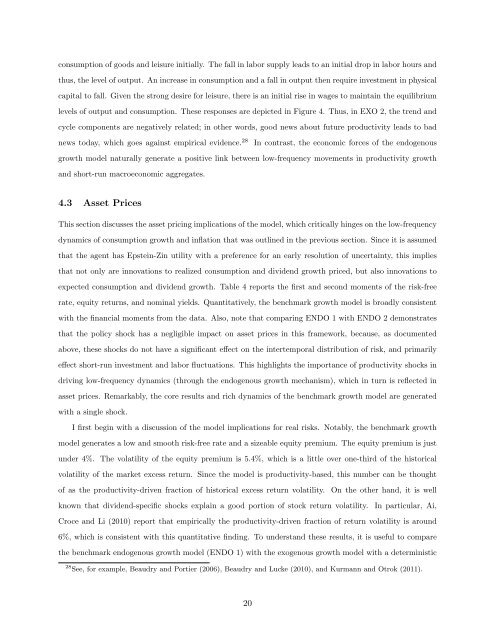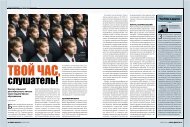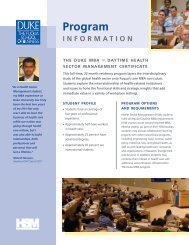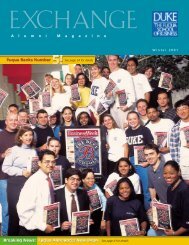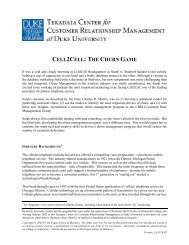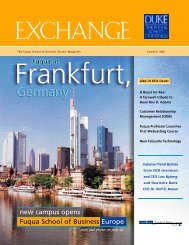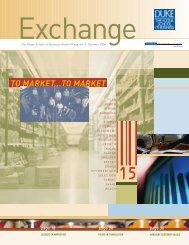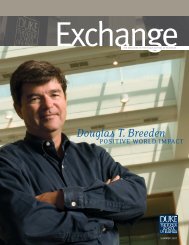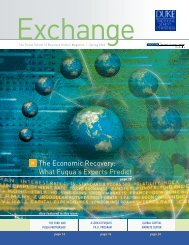Equilibrium Growth, Inflation, and Bond Yields - Duke University's ...
Equilibrium Growth, Inflation, and Bond Yields - Duke University's ...
Equilibrium Growth, Inflation, and Bond Yields - Duke University's ...
Create successful ePaper yourself
Turn your PDF publications into a flip-book with our unique Google optimized e-Paper software.
consumption of goods <strong>and</strong> leisure initially. The fall in labor supply leads to an initial drop in labor hours <strong>and</strong><br />
thus, the level of output. An increase in consumption <strong>and</strong> a fall in output then require investment in physical<br />
capital to fall. Given the strong desire for leisure, there is an initial rise in wages to maintain the equilibrium<br />
levels of output <strong>and</strong> consumption. These responses are depicted in Figure 4. Thus, in EXO 2, the trend <strong>and</strong><br />
cycle components are negatively related; in other words, good news about future productivity leads to bad<br />
news today, which goes against empirical evidence. 28 In contrast, the economic forces of the endogenous<br />
growth model naturally generate a positive link between low-frequency movements in productivity growth<br />
<strong>and</strong> short-run macroeconomic aggregates.<br />
4.3 Asset Prices<br />
This section discusses the asset pricing implications of the model, which critically hinges on the low-frequency<br />
dynamics of consumption growth <strong>and</strong> inflation that was outlined in the previous section. Since it is assumed<br />
that the agent has Epstein-Zin utility with a preference for an early resolution of uncertainty, this implies<br />
that not only are innovations to realized consumption <strong>and</strong> dividend growth priced, but also innovations to<br />
expected consumption <strong>and</strong> dividend growth. Table 4 reports the first <strong>and</strong> second moments of the risk-free<br />
rate, equity returns, <strong>and</strong> nominal yields. Quantitatively, the benchmark growth model is broadly consistent<br />
with the financial moments from the data. Also, note that comparing ENDO 1 with ENDO 2 demonstrates<br />
that the policy shock has a negligible impact on asset prices in this framework, because, as documented<br />
above, these shocks do not have a significant effect on the intertemporal distribution of risk, <strong>and</strong> primarily<br />
effect short-run investment <strong>and</strong> labor fluctuations. This highlights the importance of productivity shocks in<br />
driving low-frequency dynamics (through the endogenous growth mechanism), which in turn is reflected in<br />
asset prices. Remarkably, the core results <strong>and</strong> rich dynamics of the benchmark growth model are generated<br />
with a single shock.<br />
I first begin with a discussion of the model implications for real risks. Notably, the benchmark growth<br />
model generates a low <strong>and</strong> smooth risk-free rate <strong>and</strong> a sizeable equity premium. The equity premium is just<br />
under 4%. The volatility of the equity premium is 5.4%, which is a little over one-third of the historical<br />
volatility of the market excess return. Since the model is productivity-based, this number can be thought<br />
of as the productivity-driven fraction of historical excess return volatility. On the other h<strong>and</strong>, it is well<br />
known that dividend-specific shocks explain a good portion of stock return volatility. In particular, Ai,<br />
Croce <strong>and</strong> Li (2010) report that empirically the productivity-driven fraction of return volatility is around<br />
6%, which is consistent with this quantitative finding. To underst<strong>and</strong> these results, it is useful to compare<br />
the benchmark endogenous growth model (ENDO 1) with the exogenous growth model with a deterministic<br />
28 See, for example, Beaudry <strong>and</strong> Portier (2006), Beaudry <strong>and</strong> Lucke (2010), <strong>and</strong> Kurmann <strong>and</strong> Otrok (2011).<br />
20


